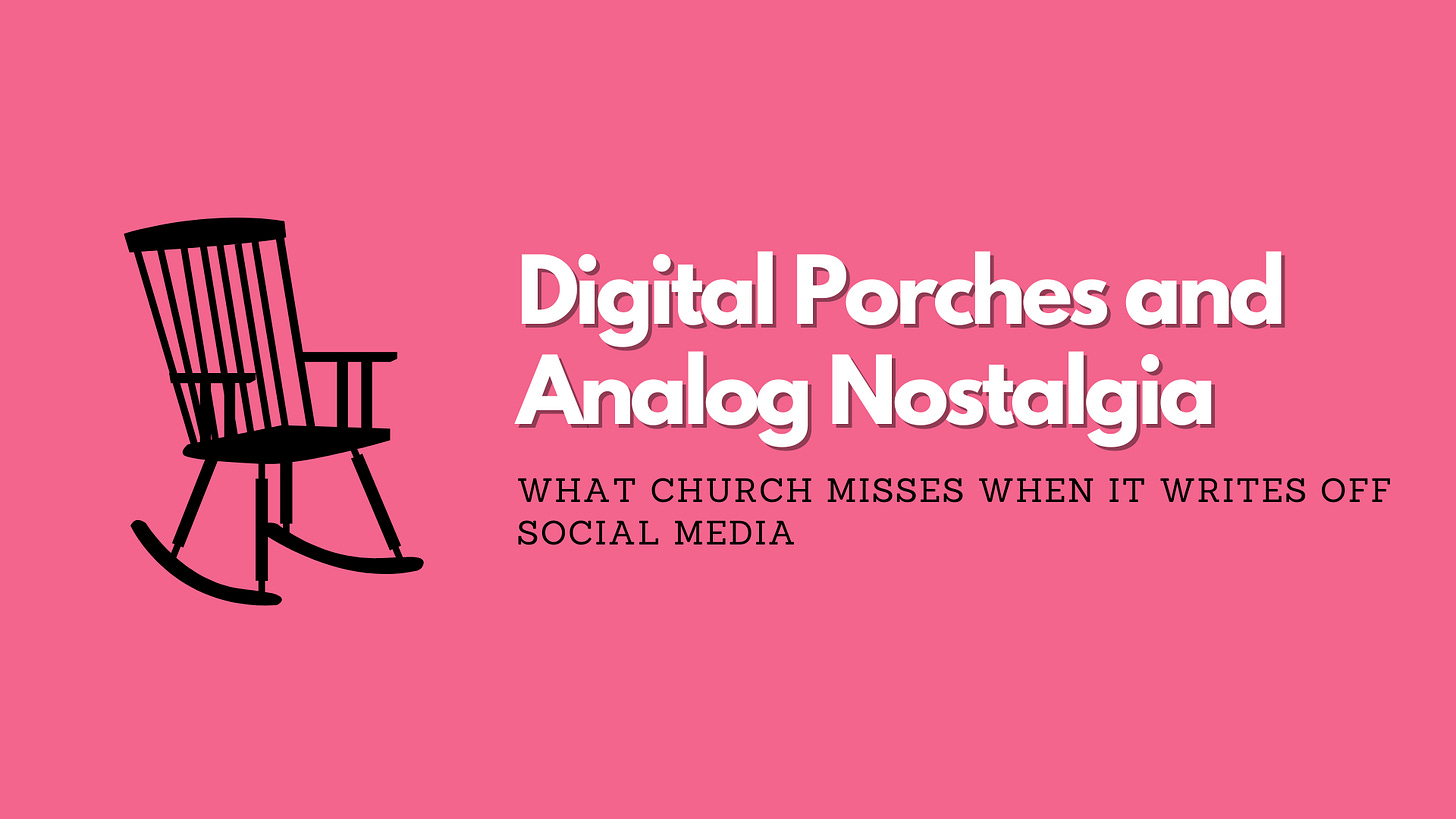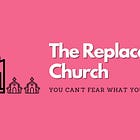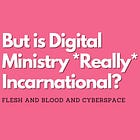Digital Porches and Analog Nostalgia
What Church Misses When It Writes Off Social Media
I’m a reader.1
I made it a practice after finishing seminary to keep up the reading habit I had to form to survive—leading to reading well over one hundred books per year since then.
One of the genres I seek out is church management, and while perusing the religion aisle, I stumbled upon a classic author who had revised one of his classic books: Creating Community by Andy Stanley and Bill Willits.
So I dove into it, and right out of the gate, the first chapter made me feel the need to respond in this space.
The chapter is titled 'People Need Community: Seeing the Lonely People.' It raises an important point—the loneliness epidemic is real.
It predates the pandemic, but COVID certainly poked a big ol’ stick in the wound.
Toward the end of the chapter, there’s this red flag that stopped me in my tracks.
“Social media has only made things worse. It promised to make those who were far away feel near, but has actually made those who are near feel far away.”
Now, I get what they’re saying.
I do.
However, that line still triggered some warning lights on my digital ministry dashboard.
Because here’s the thing: that’s a blanket statement with a lot of weight—and not much nuance. And for those of us whose churches exist in digital spaces, it feels like a dismissal we’ve heard one too many times.
The Danger of Dismissing the Digital
I understand the critique.
We’ve all seen the social scroll spiral into isolation. But to claim that social media has categorically made things worse erases an entire generation’s way of being in community.
It overlooks the birthdays celebrated over Zoom, the late-night Discord prayer requests, the Twitch streams that become weekly worship gatherings, and the Facebook groups that have prayed harder than any small group I’ve ever sat in a circle with.
It also reveals something else: a blind spot in how we talk about community.
Just a few paragraphs later, the authors shift gears and talk about front porches—the “good old days” when folks waved to each other across fences, and neighbors lingered a little longer on porch swings. They mourn the shift to back decks and automatic garage doors, the architectural retreat from neighborliness.
I get it. It’s evocative imagery. An idealized appeal to a bygone era.
But the more they described it, the more I came to the realization:
Social media is the front porch now.
It’s where we wave at neighbors—whether they live down the block or across the country. It’s where we hang out, vent, post memes, ask for prayers, and celebrate wins. It’s messy and sometimes awkward, but it’s ours. It’s a porch with an infinite number of folding chairs and a standing invitation.
To dismiss that is to miss where real connection is happening, especially for those who no longer feel welcome on the analog porch.
Presence Over Proximity
Here’s what I’ve learned about planting and pastoring a digital church: community doesn’t require proximity. It requires presence.
It requires vulnerability, consistency, creativity, and—if we’re honest—a willingness to look foolish sometimes. (Like the first time you try to host communion in a chatroom.)
Stanley and Willits are right: people do need community.
But the shape of that community has shifted. In fact, it’s still shifting.
For many, it’s more text thread than potluck. More Discord than dinner table.
That doesn’t make it less sacred. If anything, it makes it more of a holy mystery.
Am I Ahead of the Curve… or on a Collision Course?
So now I’m asking: if I’m already doing front porch ministry on the digital frontier, am I ahead of the curve? Or about to smack into a wall of assumptions that this book—bless its analog heart—just isn’t built to address?
Either way, I’m going to keep reading. Because I want to learn, and I believe that someone like Andy Stanley has a great deal to offer me in terms of building small groups. But I’ll be reading with one foot on the deck—and the other waving boldly from my digital porch.
Whether the Church realizes it or not, the porch is already online. The question isn’t whether it's real—it’s whether we're willing to show up.
Some Related Reading:
World 3-19 Complete
Q: Why did the church plant Wi-Fi instead of flowers?
A: Because they were rooting for better connection.
No, really. In case you’re curious, I read one chapter every day from seven different genres: religion, secular non-fiction, classic literature, digital ministry (when I can find one), manga, the Bible, and then one just for fun. It’s incredibly rewarding, but it’s a habit that took time to build. Thanks to those professors who assigned, like, twenty books a semester.






I find an interesting correlation between the deconstructing of digital space and the deconstructing of our idea of church. Both were built, following a natural progression of development and both outpaced a seemingly logical and conversational manner of how to grow healthy habits around them. Now both are viewed—often times (staying away from absolutes)—with having negative qualities.
However, what if we take a step back and notice what healthy practices look like so that we can truly create deep, abiding community that reflects God's grace. Especially church leaders need to be able to name—yes, in this exists unhealthy practices, but that does not mean we should just throw it away. Maybe, if we looked deep enough, worked hard enough, and discerned well enough, those thigns that have become negatives could have life in a beautiful way that fosters deep community.
Unfortunately, it is going to continue to be an uphill battle with some. I’m playing in both worlds. I’m on staff at a brick and mortar church, while trying to champion the merits of digital ministry. I truly believe there is room for both. I don’t see one as better than the other. However, I am a huge proponent of digital, as has already been established, because we have to meet people where they are. Currently, there are millions online that are not being reached by the Gospel. I want to reach those people, too.
Another great read. I believe I will keep both my digital and analog front porches.